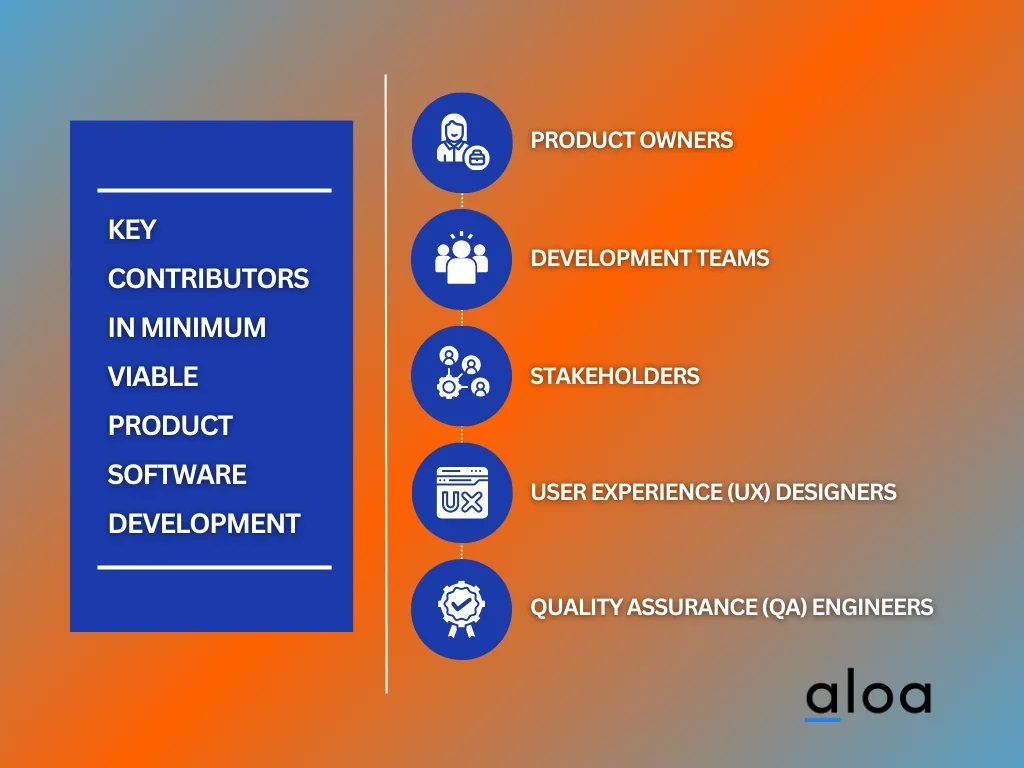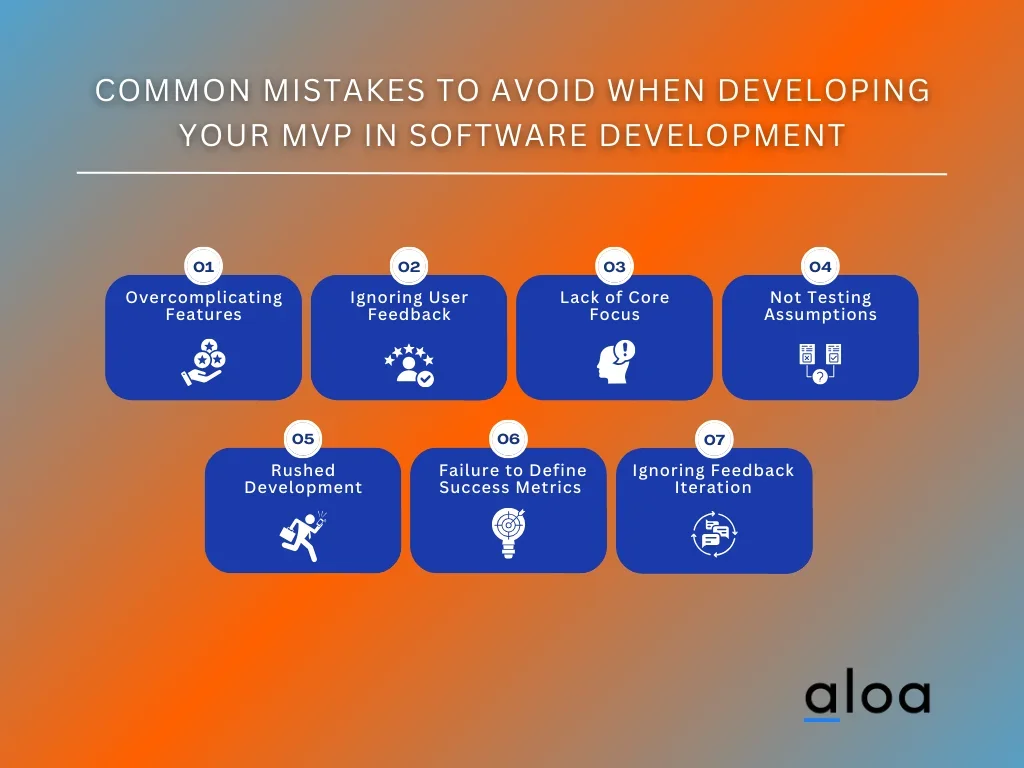Minimum viable product software development has emerged as an indispensable core of the agile methodology in today’s fast-paced tech landscape. It focuses on creating a basic product version to gather feedback and validate assumptions efficiently. This iterative approach helps reduce overall time-to-market and optimize resources effectively.
At Aloa, a software outsourcing firm, we specialize in empowering startups and businesses in their minimum viable product software development journey. Leveraging our extensive network of over 10,000+ vetted software agencies globally, we connect you with top-tier MVP software developers to hire for your project’s specific needs and requirements.
This blog will explore the minimum viable product software development stage, delving into fundamental principles and strategies to kickstart your project efficiently. By the end of this guide, you’ll clearly understand how to implement an iterative approach to product development that ensures maximum impact with minimal resources.
Let’s dive in!
What is a Minimum Viable Product in Software Development?
In agile development, a Minimum Viable Product (MVP) represents the initial version of a new product. It typically includes only core features necessary for basic functionality, enabling teams to focus on essential elements without unnecessary complexities.
The MVP is designed to launch a product version to the market quickly for initial testing and feedback gathering that helps validate the business idea and engage with the potential customer base early on in development.
This rapid deployment enables teams to gather valuable insights from real users, informing iterative improvements and ensuring alignment with customer needs.
Purpose of an MVP in Software Development
An MVP software development aims to quickly validate assumptions and test hypotheses about a product’s viability in the market. It is a strategic tool for gathering feedback from early users, facilitating informed decision-making and iterative improvements.
A comprehensive MVP focuses on essential features and functionality that minimize time-to-market and reduce MVP development costs. Itshe goal is to mitigate risk by ensuring that the final and actual product aligns closely with user needs and market demands.

Outlined below are the key contributors of Minimum Viable Product (MVP) software development, along with their specific roles:
- Product Owners: Responsible for defining the vision and prioritizing features based on user needs and business objectives.
- Development Teams: Comprising software engineers, designers, and other technical experts, they collaborate to build the MVP according to specifications and requirements.
- Stakeholders: Provide input on the overall direction of the product and may be involved in decision-making regarding feature prioritization.
- User Experience (UX) Designers: Focus on creating a seamless and intuitive user interface to enhance the user experience of the MVP design.
- Quality Assurance (QA) Engineers: Ensure that the MVP meets quality standards through testing and identifying any bugs or issues that need to be addressed.
Why is Having an MVP Important?
Having an MVP is important as it allows teams to validate product concepts and gather valuable feedback from real users early in the development process. This feedback enables informed decision-making and iterative improvements, ensuring that the final product meets user needs and aligns with market demands.
Additionally, an MVP minimizes the risk of investing resources into building a product that may not resonate with users or meet market needs. Overall, having an MVP is important for mitigating risks, maximizing resource efficiency, and increasing product success.
Minimum Viable Product Software Development: Step-by-Step Guide
Minimum viable product software development is a cornerstone for startups and developers alike. It facilitates streamlined development processes, resource optimization, and efficient product iterations. Here’s the step-by-step guide to minimum viable product software development to ensure you’ll have an organized and effective development process from conception to launch.

Step 1: Define your Objectives and Goals
In minimum viable product software development, defining objectives and goals is crucial as it provides a clear direction and purpose for the project. This involves scoping your software project to ensure that stakeholders understand the problem the MVP aims to solve and the desired outcomes it intends to achieve. Clearly defining this out results in all efforts and success within the project's defined scope.
Here are the considerations to take in defining your goals and objectives:
- Identify the Problem: Clearly articulate the problem or pain point the MVP seeks to address, ensuring alignment with user needs.
- Define Success Metrics: Establish measurable goals and Key Performance Indicators (KPIs) to gauge the effectiveness and impact of the MVP.
- Understand Target Audience: Identify the target audience and their needs, preferences, and behaviors to tailor the MVP accordingly.
- Alignment with Business Objectives: Ensure that the MVP’s goals and objectives align with the organization’s broader strategic goals and objectives.
Step 2: Identify the Core Features of your MVP
Identifying the core features of your Minimum Viable Product (MVP) determines its functionalities, which is crucial for addressing the primary problem or pain point. This step ensures that the MVP focuses on delivering maximum value to users while minimizing unnecessary complexity.
Identifying core features includes:
- Defining User Requirements: Gather insights from the target market and users to understand their needs and prioritize basic features that directly address their pain points.
- Conducting Market Research: Analyze competitor products and market trends to identify features that differentiate your MVP and meet market demands.
- Considering Scalability: Choose scalable features adaptable to future iterations and product enhancements.
- Keeping it Simple: Prioritize simplicity and usability by selecting features that provide essential functionality without unnecessary complexity or overhead.
Step 3: Create an MVP Prototype or Mockup
Creating a prototype or mockup represents the product’s design and functionality in minimum viable product software development. This step allows stakeholders to visualize the MVP early in the development process, gather feedback, and make necessary adjustments before investing in full-scale development. Integrating a video mockup generator at this stage can make the visualization even more effective, providing a lifelike preview of how the product will function
Considerations to take when creating a prototype or mock-up include:
- Choose Appropriate Tools: Select prototyping tools or software (an AI video generator or simply any mockup creator), that best suit the project’s requirements and enable the efficient creation of realistic prototypes.
- Design User Interfaces: Develop intuitive and user-friendly interfaces that accurately reflect the MVP’s intended functionality and user experience.
- Incorporate Feedback Loops: Implement mechanisms for gathering feedback from stakeholders and potential users to improve the prototype iteratively.
- Validate Assumptions: The prototype will validate assumptions and test hypotheses about user needs and preferences, ensuring the MVP meets user expectations.
Step 4: Develop the MVP
Developing the MVP involves turning your product idea into a tangible software prototype with basic features that address the core problem or need. This step entails translating the design specifications into functional code, often utilizing rapid development frameworks or agile methodologies.
Development should prioritize essential functionalities while maintaining a lean approach to minimize time and resources. Coupled with this is the importance of maintaining clear communication between developers, designers, and stakeholders to ensure alignment with the initial vision and flexibility for iterations based on feedback.
Steps 5: Test and Gather Feedback
Testing and gathering feedback in minimum viable product software development allows for evaluating the product’s functionality and user experience. This ensures that it aligns with customers’ needs in the long run. Conducting this process helps identify any issues or areas for improvement before the MVP is launched to the broader market, ensuring a higher chance of success.
Here’s a helpful guide on how to test and gather feedback:
- Conduct Usability Testing: Evaluate the MVP’s usability by observing how users interact with the product and gathering feedback on their experience.
- Solicit User Feedback: Gather user feedback through surveys, interviews, or feedback forms to understand their preferences, pain points, and suggestions for improvement.
- Perform Beta Testing: Release the MVP to a limited group of users or beta testers to gather real-world feedback and identify bugs or issues.
- Analyze User Behavior: Utilize analytics tools to track user behavior within the MVP, such as navigation patterns and feature usage, to gain insights into user engagement and preferences.
Step 6: Iterate and Refine
Iterating and refining the minimum viable product software development involves incorporating feedback and continuously improving the product. This process allows teams to address any identified issues, enhance user experience, and ensure that the MVP aligns with user needs and market demands.
When iterating and refining feedback, consider the following:
- Prioritize Feedback: Determine the most critical feedback points and prioritize them for implementation to maximize impact.
- Maintain Flexibility: Remain open to making changes and adjustments to the MVP based on new insights and feedback from users and stakeholders.
- Test Iteratively: Implement changes incrementally and conduct regular testing to assess the effectiveness of each iteration.
- Monitor Metrics: Track Key Performance Indicators (KPIs) and user engagement metrics to evaluate the impact of iterations on the MVP’s success.
- Communicate Internally: Foster collaboration and communication within the development team to ensure everyone is aligned on the changes being made and their rationale.
Steps 7: Launch and Monitor
Launching and monitoring the minimum viable product marks the culmination of efforts to bring the product to market. This phase involves deploying the MVP to real users, collecting valuable feedback, and closely monitoring its performance.
In launching the MVP, teams can validate assumptions, gather insights into user behavior, and assess the product’s market fit. Additionally, launching and monitoring the MVP is a process that enables teams to refine the product based on real-world usage and feedback to ensure its continued relevance and success in the market.
Common Mistakes to Avoid When Developing Your MVP in Software Development
In minimum viable product software development, mistakes can hinder progress and diminish the effectiveness of your MVP strategy. Here are the common mistakes to avoid when developing your MVP to ensure a smoother and more successful development process:

1. Overcomplicating Features
Overcomplicating features is a common mistake in minimum viable product software development that often leads to unnecessary complexity in the product. This occurs when developers include too many unnecessary features, making the product more complex than it needs to be.
Focusing on simplicity and the core functionality that addresses users’ needs can help avoid overwhelming users and ensure a smoother user experience. Thus, ensuring the MVP includes enough features to meet user needs without unnecessary additions is key to its success.
2. Ignoring User Feedback
In minimum viable product software development, avoiding user feedback equates to poor user experiences (UX). This often happens when teams fail to actively seek and incorporate feedback from early users, stakeholders, and target audiences. Consequently, overlooking user feedback can result in a product failing to address users’ needs or preferences.
3. Lack of Focus on Core Value Proposition
Lack of focus on core value proposition is another common mistake in minimum viable product software development. This often occurs when teams need to catch up on the primary problem or pain point the MVP aims to solve. In turn, diverting attention to unrelated features dilutes the product’s purpose and can confuse users.
4. Not Testing Assumptions
In minimum viable product software development, not testing assumptions is a common mistake to avoid. This oversight normally occurs when teams proceed with product development based solely on assumptions without validating them through testing or research. Additionally, not testing assumptions can lead to building a product that doesn’t resonate with users or address their needs.
5. Rushing the Development Process
Rushing the development process is a critical mistake to avoid during a minimum viable product software development, as it often leads to subpar results despite the least effort. This often happens when teams prioritize speed over quality, skipping necessary steps such as thorough testing and validation.
As a result, rushing the development process can lead to a product riddled with bugs and failing to meet user satisfaction, ultimately requiring more effort to rectify issues in the long run.
6. Failure to Define Success Metrics
Success metrics are measurable goals or criteria that help teams understand whether the MVP has achieved its intended objectives. Failure to define these metrics can lead to ambiguity and make it challenging to assess the MVP's performance accurately.
Having that said, a defined success metrics makes it easier to determine whether the MVP has achieved its intended goals and business objectives.
7. Not Iterating Based on Feedback
Failing to iterate based on feedback is another common mistake to avoid in a minimum viable product in software development. This occurs when teams do not actively incorporate user feedback into their development process to make necessary improvements. As a result, this leads to a stagnant product that fails to evolve and meet user needs effectively.
How To Measure the Success of Your MVP
In measuring the success of your minimum viable product software development process, understanding key metrics and indicators is essential for evaluating its effectiveness and impact. Below, we’ve outlined the essential common metrics and strategies to employ when assessing the success of your MVP.

1. Define Clear Success Metrics
Defining clear success metrics is essential when measuring the success of your Minimum Viable Product (MVP). This involves establishing specific, measurable goals that align with your product’s objectives, such as user engagement, conversion rates, or customer satisfaction.
Additionally, clear success metrics enable you to identify areas for improvement and make data-driven decisions to optimize your product’s performance. Ultimately, defining clear success metrics empowers you to accurately measure the impact of your MVP and assess its overall success in achieving its intended goals.
2. Set up Analytics Tracking
Setting up analytics tracking is crucial when measuring the success of your minimum viable product software development. Doing so allows you to gather valuable data on user interactions and behavior. With careful analysis, this data provides insights into how users engage with your product, along with the features they find most valuable and even to areas for improvement.
Here’s how to set up analytics tracking:
- Choose an Analytics Platform: Select a robust analytics platform that aligns with your needs and allows for detailed tracking of user interactions.
- Define Key Events: Identify key user actions within your MVP, such as sign-ups, feature usage, or conversions, and set them up as events to track.
- Implement Tracking Code: Integrate the analytics tracking code into your MVP to collect user interactions and behavior data.
- Set up Custom Reports: Configure custom reports within your analytics platform to track specific metrics relevant to your MVP’s objectives.
- Regularly Analyze Data: Continuously monitor and analyze the data collected through analytics tracking to gain insights into user behavior and inform decision-making for future iterations of your MVP.
3. Collect User Feedback
Collecting user feedback, including through customer validation, is a crucial aspect of measuring the success of your Minimum Viable Product (MVP). Consistently collecting and applying them provides valuable insights into user experiences and preferences. Also, as you engage with users, it allows you to gather first-hand feedback on what aspects of the MVP work well and what areas need some improvement.
Some practical strategies for collecting user feedback include:
- Implementing Feedback Channels: Provide various channels for users to share feedback, such as feedback forms, surveys, or in-app feedback mechanisms.
- Encouraging Open Communication: Foster a culture of open communication with users, encouraging them to share their thoughts, suggestions, and concerns freely.
- Actively Listening: Pay close attention to user feedback, actively listening to their comments and considering their suggestions when making decisions.
- Analyzing Feedback Data: Collect and analyze feedback data systematically to identify common themes, trends, and areas for improvement across user feedback.
4. Analyze Data and Feedback
Collecting user feedback and analyzing data are integral steps in measuring the success of your minimum viable product software development. This process systematically reviews feedback and data to gain insights into user experiences, preferences, and behaviors.
Additionally, analyzing qualitative and quantitative data allows for a comprehensive understanding of how users engage with your MVP and its impact on their experience. Ultimately, this analysis informs strategic decisions for optimizing your MVP and ensuring its success in meeting user needs.
5. Monitor Key Performance Indicators (KPIs)
When measuring the success of your Minimum Viable Product (MVP), monitoring Key Performance Indicators (KPIs) provides insights into its performance and effectiveness. This involves tracking metrics based on your MVP’s objectives, such as user engagement, conversion rates, or revenue growth, to assess its overall impact and success.
To successfully monitor KPIs, consider the following:
- Define Relevant KPIs: Identify and define KPIs that directly reflect the success of your MVP in achieving its objectives.
- Set Benchmarks: Establish benchmarks or targets for each KPI to provide a precise performance measurement and comparison goal.
- Utilize Analytics Tools: Leverage analytics tools and platforms to track and measure KPIs accurately, providing real-time insights into your MVP’s performance.
- Adjust Strategies as Needed: Based on KPI analysis, adapt and adjust your strategies and tactics to optimize your MVP’s performance and drive towards its objectives.
Key Takeaway
Minimum viable product software development offers startups, developers, and businesses a strategic framework for building a successful software product. Prioritizing simplicity, user feedback, and iterative development in the MVP development process enables teams to validate assumptions, minimize risks, and deliver value to users efficiently.
Additionally, through careful planning, iterative refinement, and continuous monitoring, MVPs empower teams to adapt to market demands, iterate on product ideas, and ultimately build products that resonate with users.
Aiming to start your minimum viable product software development process now? Explore the Aloa hire page to discover how our team and partner network can help you get started. Our Account Executives will walk you through on how to expertly build this out while working with the reliable team of software developers in the industry.

